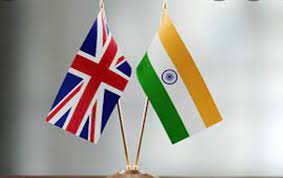16 Aug 2022 Trade between India and UK

Context
- Trade between India and the UK is expected to double by 2030, according to Grantthornton’s Britain Meets India (BMI) report, a target set by investment in proposed free trade agreements in technology diversification of global supply chains and the Confederation of Indian Industry (CII). It can be easily achieved in business partnership with.
- Professional services is the top sector in India by UK companies, with Maharashtra as a major investment destination, followed by the National Capital Region and Karnataka.
Proposed Free Trade Agreement:
- The proposed FTA is expected to boost Indian exports in labour-intensive sectors such as leather, textiles, jewellery, processed agricultural products and marine products, education, pharma and healthcare.
- The UK may consider reducing tariffs on products such as Apple, UK-made medical devices and machinery.
- UK companies also expect India to strengthen data privacy and enforce contracts.
UK-India trade:
- The UK remained the 6th largest investor in India with a cumulative investment of around USD 31.92 billion during FY 2021-22.
- It is about 5.4% of the total foreign direct investment (FDI) in India.
- India’s trade in goods and services with the UK stood at US$ 31.34 billion in FY 2022, up from US$ 19.51 billion in 2015.
- 618 UK companies have been identified in India, they together employ about 4.66 lakh people and have a total turnover of Rs 3,634.9 billion.
New developments in India-UK relations:
- Despite the challenge posed by the Ukraine crisis, India-UK relations have been on an upward trajectory, exemplified by the conclusion of a Comprehensive Strategic Partnership in 2021.
- The agreement also established the 2030 Roadmap for India-UK relations, which primarily outlines partnership plans for bilateral relations.
- The two countries discussed on deepening defense-related trade and cyber security and defense cooperation.
- A new joint cyber security program to protect online infrastructure in India and the UK is to be announced.
- India and the UK also plan to hold the first Strategic Tech Dialogue, a ministerial summit on emerging technologies.
- Additionally, the UK and India have agreed to strengthen their cooperation in the maritime domain as the UK joins India’s Indo-Pacific Ocean Initiative and becomes a major partner on maritime security issues in Southeast Asia.
- In January 2022, India and the UK concluded the first round of talks for an India-UK Free Trade Agreement.
- The talks reflected shared ambitions to conclude a comprehensive deal between the world’s fifth (UK) and sixth (India) largest economies.
Free Trade Agreement (FTA)
- It is an agreement between two or more countries to reduce barriers to imports and exports.
- Under a free trade policy, goods and services can be bought and sold across international borders, for which provisions such as little or no government fees, quotas and subsidies are made.
- The concept of free trade is the opposite of trade protectionism or economic isolationism.
India and FTA:
India-Australia ECTA:
- India will benefit from the preferential market access provided by Australia on 100% of its tariff lines.
- India will give preferential access to Australia on over 70% of its tariff lines.
South Asian Free Trade Area (SAFTA):
- This free trade agreement is limited to goods, excluding all services such as information technology.
- Agreement was signed to make the customs duty of all traded goods zero by the year 2016.
Other trade agreements signed by India
India-UAE Comprehensive Economic Partnership Agreement:
- The Comprehensive Economic Partnership Agreement (CEPA) provides an institutional mechanism to encourage trade between the two countries.
Comprehensive Economic Cooperation and Partnership Agreement (CECPA) between India and Mauritius
- It is a kind of free trade agreement which aims at providing an institutional mechanism to encourage and improve trade between the two countries.
- Under this agreement, countries reduce or eliminate duties on products. Countries also relax norms to promote service trade.
South Asia Preferential Trade Agreement (SAPTA):
- It came into force in the year 1995 to promote trade between the member countries.
Asia Pacific Trade Agreement (APTA):
- First the Bangkok Agreement, a preferential tariff regime aimed at promoting intra-regional trade through the exchange of concessions mutually agreed upon by member countries.


No Comments